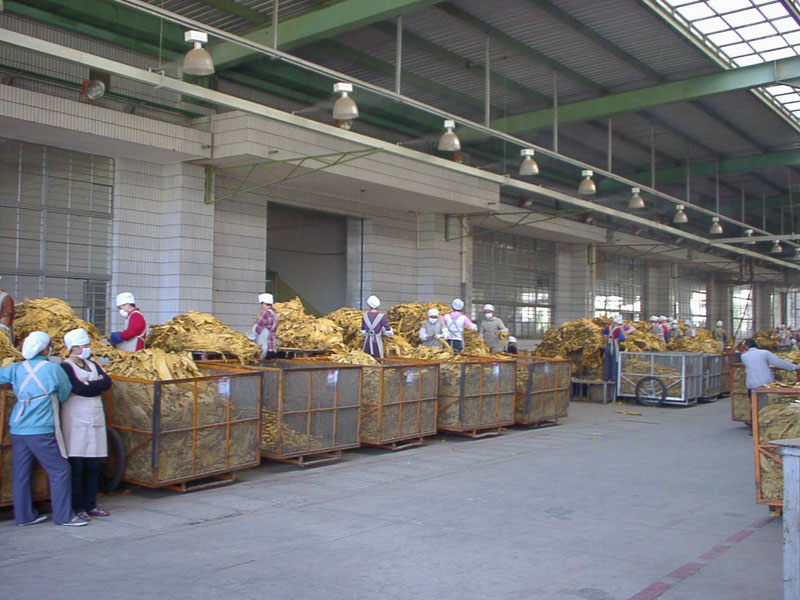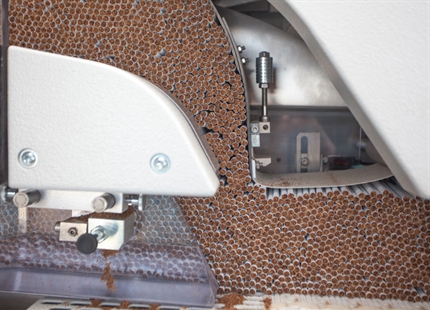
Author: Steve Hale, Technical & Business Development Manager, Condair plc
Correct humidity equals maximum productivity
Tobacco leaves and paper are extremely hygroscopic materials – that is they are both affected by the ambient moisture content of the surrounding air. If the humidity level of the surrounding air is low, moisture is drawn from the materials, drying them out and degrading their properties. This can lead to anything from tobacco shrinking and falling out of cigarettes to cigar leaves cracking and paper misfeeding onto machines causing delays on the production line.
Each stage of manufacturing cigars and cigarettes requires very specific humidity levels to maintain the moisture content of the materials involved, ensuring production efficiency and product quality.
Primary manufacture
When tobacco is first brought into the factory in bales and opened it is extremely dry. One of the initial processes, often referred to as softening, involves the tobacco leaves passing through a large steam-filled rotation cylinder. These areas have a very high typical humidity of 85-88%RH (relative humidity) at 30-32°C due to moisture leakage from the process into the ambient air. During this process the tobacco will increase in moisture from about 1-2% to some 24% moisture by weight dependent on the client requirement.
After the tobacco has been softened the stems of the leaves are removed. During this stemming and stripping process the conditions should be about 70-75%RH and 24-29°C in order to prevent the tobacco from drying out. The tobacco then undergoes its final process in this area, casing and conditioning, where it is flavoured. In most production plants the tobacco will leave the Primary area with a moisture content of between 13-16%. This requires an ambient equilibrium humidity of between 60-68%RH to prevent moisture loss.
These areas must be maintained at between 60-70%RH...as they have large amounts of tobacco exposed to the ambient air.
Due to the fact that steam is involved in this process the humidity in the Primary area often does not need to be maintained by humidification systems as the leakage from the process will maintain the ambient humidity at a suitable level. However, in some factories the processes are so well sealed that there is almost no steam leakage from the process and therefore humidification systems are needed to maintain the required conditions.
Tobacco Storage areas
After these initial processes the moistened tobacco is conveyed to large, normally open, bins or silos, where it is stored until needed by the manufacturing machines. Some smaller tobacco plants will not have silo storage but will rely on “Box” or "Cut” tobacco stores.
These areas must be maintained at between 60-70%RH and 21-24°C as they have large amounts of tobacco exposed to the ambient air. If humidity is not maintained at these equilibrium levels the tobacco will start to dry.
Filter Production
Filter rod production is one of the few areas that has no real need for humidification as the material used for the filters is not particularly moisture sensitive. However, if the humidity drops below 50% electro-static charges can build up. This can cause filters to stick together and damage the fluidity of their movement to the production area. For this reason it is advisable to maintain the humidity above 50%RH and around 21°C as this will totally eliminate static. Static charges will build up when the ambient humidity is below 45% humidity irrespective of the temperature of the area.
Cigarette production areas
This is probably the most important area as far as humidity control is concerned. The tobacco is normally delivered to the cigarette machine, via ducts using compressed air, into a hopper above the maker. The tobacco is forced through a garniture in the shape of a cigarette and is then wrapped in paper. The amount of moisture the tobacco loses in this process depends on the speed of the machine and the exposure time to the ambient and compressed air used to transport it from the storage area.
The paper that the cigarette is wrapped in also has to be kept in equilibrium with the environment when it is stored on its reel. If its moisture content changes so will the dimension of the reel of paper along its exposed edges. This can lead to tears, machine miss-feeds and expensive downtime re-feeding the roll.
Most cigarette production areas are held at 65-68%RH. The relative humidity in this area is critical as it maintains the equilibrium moisture of the tobacco around 13% to 16% by weight, the exact moisture content being product and blend related. If the humidity falls below about 60%RH, the tobacco will start to lose moisture and dry. This can in severe cases cause the tobacco to drop out of the cigarette when it is held upside down. If the humidity exceeds 70%, the moisture addition can cause staining on the paper, which is unacceptable to the end client. Therefore the maintenance of humidity in production areas at 65%RH +/-5% is critical to the production and the quality of the product.
During the cigarette manufacture and after the filter is inserted, the filter may be lasered to burn small holes that allow air to be drawn into the smoke to control the smoking characteristics of the cigarette. During the lasering process the humidity needs to be kept at about 55%RH to prevent clogging of the suction holes in the holder. It is sometimes necessary to dehumidify this section of the machine to achieve this 55%RH level. This can be easily achieved by using small adsorption dehumidifiers mounted along side the maker and the “dry” air ducted into the Lasering section.
Once the cigarette is complete it is fed onto a delivery system. From here it will take one of two routes depending on the type of machine. Older style machines that do not have a packing machine directly attached will deliver the cigarette to a sorter and then place them into trays holding around 10,000 cigarettes each. These are then moved on trolleys to another part of the production area where they are packed into cartons. Most of the modern machines will have built-in packing sections to take the product directly from the maker and pack into 20’s and then into cartons of 200.
Maintenance of humidity in the production area during shutdown periods...allows product to be left on the machine without loss of moisture.
Linked to the packing machine can be a storage/buffer system, which can hold several thousand cigarettes at any one time. The buffer is used to take the production from the maker, if making is faster than packing, and conversely it will keep the packing line supplied if the maker is running slower. The maintenance of between 60-70%RH in and around the storage system is again critical. The cigarettes can be stored for several hours in the buffer and being exposed to ambient conditions would change their equilibrium moisture if the relative humidity is not maintained at a nominal 65%.
Maintenance of humidity in the production area during shutdown periods, weekends, meal breaks, etc, allows product to be left on the machine without loss of moisture, weight and quality. This gives the advantage that product is available instantly without having to wait for the maker to produce stock when production restarts.
There is one final area that is sometimes humidified, the ripping room. This is where cigarettes that have not been made correctly and production waste are broken up and the tobacco recovered, with the paper and filter being sent to waste. Any loss in moisture will lead to poor recovery of tobacco so again these areas are generally maintained at about 65%RH at 21ºC.
In order to maintain good humidity control in the any of the production and storage areas, it is vital to maintain the temperature through the heating, ventilating and air conditioning systems. These systems can introduce large volumes of fresh air to the production hall depending on how they have been set up. Additionally most of the cigarette making machines will have dust recovery systems, based on vacuum extraction. This extraction has to be compensated for by the air handling plant, which will also lead to large amounts of fresh air being introduced to the production area.
With these large air volumes being constantly introduced, the amount of moisture that needs to be added can be very high, so great care is needed in the design of the humidification systems. It is often forgotten that in winter when cold and wet air is drawn into the building from outside and heated, the air’s relative humidity will fall. For instance, winter air entering the building at 0ºC and 80%RH, when heated to 21ºC will give a relative humidity of around 24%. With 65%RH being required to maintain the tobacco’s moisture content, any air introduced with a relative humidity of 24% would lead to moisture loss from the tobacco without correct humidification.
Humidity Control
Humidifiers have been around for a number of years in various shapes and forms. They raise humidity by either releasing cold water or steam into the atmosphere. For large industrial applications like cigarette production, heating water to produce steam would be too expensive so cold-water humidifiers are the norm for this industry.
The most common type of cold water humidifier is a spray atomising system. They come in a wide variety of types, such as air and water atomising nozzles and high-pressure systems.
Most widely used in the tobacco industry are air and water atomisers, such as the JetSpray, which employ nozzles to combine pressurised air and water to produce a very fine spray. This spray quickly evaporates raising the humidity to the desired level. The nozzles are strategically located around the ceiling area of the production plant to give the correct distribution of moisture whilst also avoiding existing fittings such as lighting, air conditioning or ductwork.
Nozzle-based humidifiers can cope with a very high capacity, give close control and, in the case of the JetSpray humidifier, maintenance is minimal due to a self-cleaning mechanism that avoids blockages. With the correct annual maintenance, this type of system can give years of trouble free operation, which in a busy working environment is essential. The nozzle is precision engineered to ensure correct atomization without the risk of drips. Systems are available with capacities up to 600 litres per hour.
These features make this type of system ideal for industrial applications. Even though many atomising nozzle systems run directly from the potable mains water supply, all cold-water humidifiers should employ failsafe UV sterilisation or silver ion dosing and regular automatic water purge cycles to ensure cleanliness.
Any water quality can be used. If mineral dust left behind from the evaporating water is a problem, which is unusual in most production areas, this can be eliminated using a demineralised water supply from a reverse osmosis water purification system. In contrast, the humidifier system also has the added benefit of suppressing existing dust in the atmosphere and giving a cooling effect, making the working environment more pleasant for staff.
Depending on where the production facility is in the world, the amount of humidity control will vary according to seasonal climatic changes. In cooler regions indoor heating will greatly affect the amount of moisture that is needed so winter seasons will create the largest humidity demand.
Quality and Productivity
Wherever a factory is located humidity control is always essential. Without it production is less efficient and product quality suffers. Ensuring that the tobacco and paper maintain their optimum properties from when they enter the factory to when the cigarettes are sealed in their protective packaging is a complex but always profitable calculation.
Condair has spent over 30 years humidifying the tobacco industry with clients including BAT, Alfred Dunhill, Imperial Tobacco, Rothmans International, Gallagher and Altadis Seita. The company offers a comprehensive service of advice, design, supply, installation and maintenance.

















